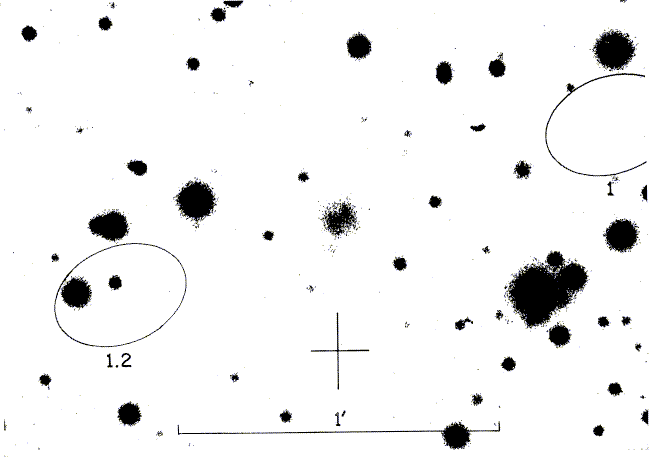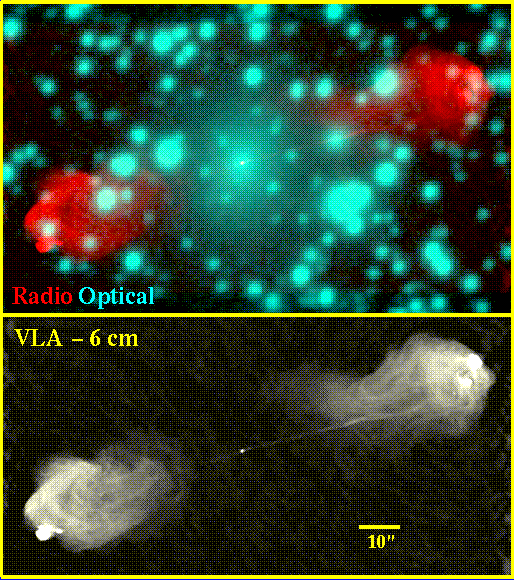
Active galactic nuclei (AGN) may be defined loosely as the central regions of galaxies which show substantial energy release beyond what can be attributed to normal processes from stars, ISM, and their interactions. This includes Seyfert galaxies, radio galaxies, quasars, QSOs, BL Lac objects, and possibly the common LINERs in ordinary galaxies. They may also encompass N-galaxies and X-ray bright galaxies. These classifications are not necessarily mutually exclusive, being based on disparate criteria.
Recognition that galactic nuclei can be sites of very energetic and compact phenomena largely began with the identification of strong radio sources with galaxies - sometimes peculiar in form, frequently with the radio emission arising in the form of a pair of sources symmetrically located about the galaxy ("double-lobed radio source"). Early interferometer positions for the lobes are superimposed in a photograph of Cygnus A in Fig. 15 of Matthews, Morgan, and Schmidt 1964 ApJ 140, 35 (courtesy of the AAS):

illustrating the general pattern of two patches of emission. The central galaxy (more specifically the nucleus) is implicated in powering the emission. More detailed radio maps show intricate structures in the emission, including jets pointing out from a submilliarcsecond core (generally shown to be less than a parsec in size, sometimes much less). Such structure is well shown in the VLA map of Cygnus A by Perley et al. (1984 ApJLett 284, L35) shown here in a logarithmic display of their data from the NRAO Radio Universe CD-ROM with a superposition on the optical field for comparison.

The major classes of AGN (radio galaxies, quasars, Seyfert nuclei, and BL Lac objects) were found in rather different ways.
Radio galaxies were found as the optical counterparts of radio sources from early surveys - see Matthews, Morgan, and Schmidt 1964 (ApJ 140, 35). Their optical spectra may or may not show emission lines; when seen, the lines may be narrow- or broad-lined, giving continuity to QSOs and Seyferts of types 1 and 2. The radio structures are often twin-lobed, showing one or two jets tracing back to the nucleus when observed with high resolution and dynamic range.
Quasars (quasi-stellar radio sources) were first thought to be radio-loud stars, when interferometry or lunar-occultation positions allowed precise identification (as for 3C 273, Hazard, Mackey and Shimmins 1963 Nature 197, 1037). In this case, the optical identification was a 13th-magnitude stellar object with optical jet, approximately matching the radio structure. The spectrum was finally recognized by Schmidt (1963 Nature 197, 1040) and Greenstein and Schmidt (1963, ApJ 140, 1) as showing broad Balmer emission lines at z = 0.158. This immediately implied a size less than 500 pc and luminosity of order 1046 ergs/sec. Smith and Hoffleit (1963 PASP 73, 392) showed that archival patrol plates indicated rapid optical variability, such that the light-crossing time across the optical continuum region can be no longer than some months. This implies a synchrotron source lifetime of 1011 seconds, and a BLR less than 1 pc in size needs only a few times 105 solar masses for the observed line radiation because UV ionization is so rapid after recombination.
Seyfert galaxies were first pointed out by Seyfert 1943 (ApJ 97, 28). They are defined by the optical spectra, showing rich line spectra covering a wide ionization range with line widths of hundreds to thousands of km/s. Both these properties distinguish them from normal emission spectra from H II regions. Types 1 and 2 were distinguished by Khachikian and Weedman 1974 ApJ 192, 581). Type 1 objects show different Balmer-line and forbidden-line profile, so that the Balmer lines have very broad wings (like QSOs and BLRGs=broad-line radio galaxies). Type 2 objects have essentially the same line widths for all the emission lines. The broad-line region (BLR) virtually requires a massive central object, since the velocities are much higher than any normal galaxy escape velocity.
BL Lac objects were in some cases first catalogued as variable stars (BL Lacertae, AP Librae). They are highly variable, highly polarized, and show virtually featureless continuous spectra. It took delicate measurements of the surrounding galaxies (i.e. Miller, French, and Hawley 1978 ApJLett 219, L85) to determine redshifts, though a few show measurable weak emission lines when the core is faint. These have occasionally been considered as bare QSO cores, with no surrounding emission-line regions, and more recently as the best candidates for Doppler-boosted radiation from relativistic jets directed toward us. There are samples selected from radio and X-ray flux-limited samples, whose slightly different properties may carry information on how these spectral ranges are related. The optically violently variable (OVV) quasars are similar in many respects, and are often lumped together with BL Lac objects as blazars.
All of these kinds of AGN always occur in galactic nuclei, in the center of a deep potential well. This is a good place to form a massive compact object, which is a good bet on energetic grounds as well - gravitational energy release in a very deep potential well can be as efficient as mc2/2, much higher than fusion. Most people use the working hypothesis that a black hole is involved, largely influenced by the discussion of Rees (1978 Physica Scripta 17, 193, redrawn here following the version in Begelman, Blandford, and Rees in Rev. Mod. Phys. 56, 255) that anything that massive and compact either is or will soon be a black hole:

Most of the detailed information on conditions around AGN has come from emission lines, due to their ability to trace kinematics and ionizing processes. They figure prominently in distinguishing the various categories of AGN (perhaps superfluously) - see this comparison of the optical spectra of various kinds of AGN. As may be seen from this list, the various classifications are not mutually exclusive:
There are further grab-bag classes selected in single wavelength bands that may, for example, effectively find heavily obscured examples (such as X-ray galaxies, of which some are Sy 2, and luminous far-IR sources, some of which are dust-obscured broad-line objects).
The sequence from Seyfert to QSO (at least radio-quiet ones) is largely one of luminosity, but a bright enough AGN may alter its surroundings by ionizing all the ISM, sweeping the area clean via a wind, or triggering star formation. The host galaxies of QSOs might not be remotely normal by present-day standards even if there is real physical continuity all along this sequence. There has been discussion of the distinction between radio-quiet and radio-loud AGN being between spiral and elliptical host galaxies, as in nearby objects. It is not clear what this might mean at early cosmic times, and in fact HST imagery of QSO hosts at z ~ 0.4 shows that life is more complicated.
Last changes: 10/2000 © 2000